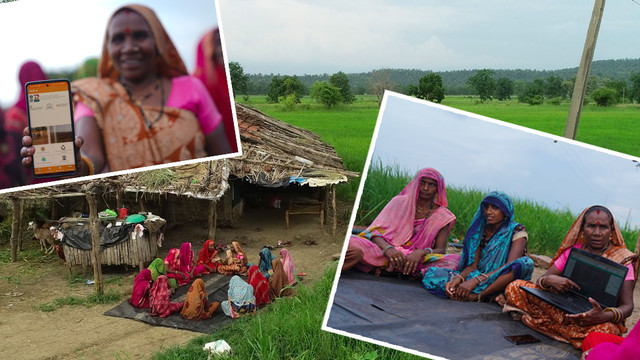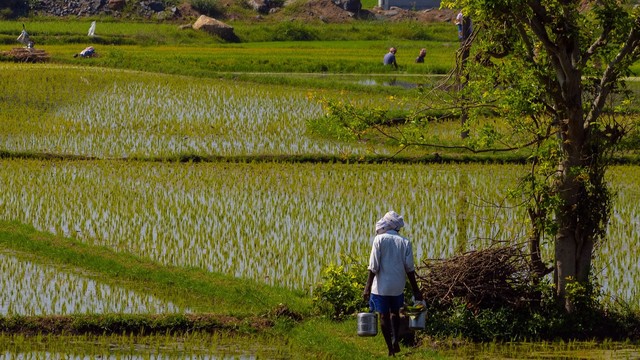How far can non-state relief reach?
During the COVID-19 pandemic, organisations other than the government were vital in providing social protection in the form of aid, food and medical support to urban communities in India.

Health checks for COVID-19 in India (Photo: Gwydion M Williams, via Flickr, CC BY 2.0)
Across the COVID-19 pandemic, talk of relief and mutual aid remained one of the important positive legacies of a difficult period. A variety of what we can think of as ‘non-state actors’ – civil society and non-governmental organisations, unions, worker organisations, religious organisations, newly made volunteer networks often no more than a WhatsApp group – came together to provide aid, food and medical support, all elements of urban social protection and safety nets.
Indian cities were no exception. In particular, in the second wave of COVID-19 in 2021, a remarkable effort centered around food relief emerged in New Delhi.
Called the Delhi Coordinated Relief Group (Delhi group), nearly 40 organisations came together to undertake the work of food relief in the city. The group had members from membership-based organisations of workers in the informal economy, community-based organisations, worker unions, NGOs, individuals and resident activists. This network has been documented extensively in the archive.
Scholars and policymakers have argued that relief offered during COVID-19 has critical lessons towards the delivery of social protection even outside crises. One of these lessons is to deepen and take seriously the role of non-state actors as institutions that can anchor the delivery of social protection.
Yet a question arises: can non-state actors work at an adequate scale in this capacity? Often, these actors are seen, at best, as partners that offer ‘last-mile connectivity’, and are thought to be ‘local’ in contrast to the state’s institutions that must have universal or at least widespread reach.
It is without doubt that the role of the state must be central in the provision of urban social protection. Yet the experience of the Delhi group helps us examine a particular question: what could be the scale at which networks of non-state actors can work? Are they, indeed, limited to the ‘local’ or can they act, more broadly, for example, as a dispersed urban infrastructure capable of partnering with the state at a much broader scale?
Using a set of maps that show where the Delhi group delivered its food relief, we show that the network indeed acted far beyond the ‘local’. Its geographies were by no means universal, as they would have to be with state action, but were significant, and suggest, as we will argue later, that non-state actors can act as social infrastructures with wide reach, especially as partners to the state not just in crisis but in the delivery of ordinary social protection even after it.
Mapping the relief
The Delhi group focused on one form of food relief – the delivery of kits of dry food rations to families that they could use for a month. These ‘ration kits,’ as they are called colloquially, included rice, wheat, oil, lentils, spice packets and, in different configurations, additional food items such as biscuits, as well as masks and sanitary hygiene items. Special kits for children were also made that included formula, eggs, milk packets and fruits. Assembling and delivering kits required a complex delivery chain of assembly, packaging and then distribution.
By most measures, the Delhi group was a success. The network distributed nearly 75,000 ration kits from April 2021 to June 2021. Below, we map where these kits were delivered. The data points that were collected to make these maps come from the archive of the group, of which authors of this blog were members. This video describes the system of demand generation and delivery used by the network.
The map below shows the delivery across the city. At first glance, what is apparent is to see the wide geographical coverage. The Delhi group reached over 100 city neighbourhoods and delivered food to 300 locations in the city.
This is a significant feat. New Delhi is one of the world’s largest cities, with between 17-22 million residents depending on how you count, and a coverage of nearly 1,500 square kilomemtres. Relief reached all of the 11 districts in the urban region, and 45% of its wards, the smallest unit of urban governance in Indian cities.
And it is worth remembering that this was done under the transport restrictions of one of the world’s strictest lockdowns, with significant risk of infection during the delta phase of the virus.
A thickness of presence
One of our first readings of this map is that it is a geography of the footprint of non-state actors in the city. The extent of the distribution and its coverage in most corners of the city shows that – when networked – civil society actors have a significant geographical coverage of what is a very large urban region.
We can think of this as a ‘thickness’ of the presence of the Delhi group members in various sites in the city. These sites, variously, are neighbourhoods and workplaces, as well as worker and identity-based communities, and non-state actors have formed connections in each through continuous and long-term work undertaken on various issues such as gender, employment, housing and its allied rights, and so on.
This engagement-based presence is another form of ‘thickness’. Building long-term relationships with places and communities gives non-state actors critical forms of knowledge. Put simply, they know who and where vulnerable communities are, understand their lifeworlds and are also, in turn, known by them. These two forms of thickness – presence as well as what we can think of as an embedding – can help to strengthen not just delivery and identification but micro-level design of social protection systems.
The geography is also particular. The spread of the network has a pattern that emerges if we map delivery sites to the most widespread forms of vulnerable housing in the city: recognised informal settlements, industrial clusters and low-income neighbourhoods.
The map below takes just one of these – recognised informal settlements in the city – and maps them against food delivery sites. The mixing of the red and the blue dots shows that the geography of non-state actors is, then, also a particular geography of vulnerability. Particularly in cities of the global South, many non-state actors are proximate to some of the city’s most vulnerable communities. This then is a third form of ‘thickness’ of presence.

Map showing how non-state actors are present near the city's most vulnerable communities – the so-called 'thickness of precence' (Map: Amruth Kiran, Geospatial Lab, IIHS)
Non-state actors as a social infrastructure
We started this blog by arguing that there is a tendency to speak of relief, mutual aid and work by civil society actors more broadly as local and localised, particular to their membership communities (workers for unions, residents for a local neighbourhood association), as well as a ‘last-mile’ connection or gap-filling mechanism. Yet COVID-19 showed that non-state actors can, in fact, be a social infrastructure.
By using the term ‘infrastructure,’ we mean that they can act as networks, work at scale, and be held accountable to equitable and wide-spread delivery.
Yet if non-state actors are to play a role in the delivery of social protection outside of crisis, this means that they, like all infrastructure, need governance structures that both support as well as regulate them.
Thinking of non-state actors as a social infrastructure also raises important questions of the kind of recognition, support and regulation they then require to function efficiently, but also equitably and accountably.
We have spoken elsewhere of what these forms of governance can look like – showing how the state must recognise, support and work with NSAs if they are to reach the potential they have shown in the pandemic and before. For non-state actors, on the other hand, there are crucial lessons of the gains from working as a network, which we have documented in a podcast.
What the maps remind us of is the importance of investing in working with non-state actors beyond the pandemic, and taking them seriously as significant actors in the delivery of social protection.
It is then that the thickness of presence, knowledge and proximity to vulnerability can help re-energise social protection systems, particularly in cities of the global South.
Authors

Gautam Bhan, associate dean, School of Human Development at Indian Institute for Human Settlements

Rashee Mehra, consultant at Indian Institute for Human Settlements
The authors would like to acknowledge the support from Nidhi Sohane and Amruth Kiran to prepare the archive database for mapping.



